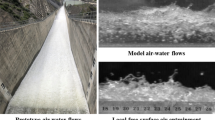Abstract
The chute aerators separate the flow from the chute bottom, and the air can enter into the flow through the lower surface. In this study, the air concentration and the pressure along the chute bottom are investigated systematically by a series of model tests with the upper aeration effect being eliminated. The chute downstream the aerator is partitioned into four zones: the cavity zone, the impact zone, the equilibrium zone, and the far zone. It is found that a large amount of air entrained in the cavity zone is only partially entrained into the flow finally. Furthermore, the lower air discharge is decreased sharply in the impact zone, and the detrainment disappearsonthe section of x = Lm. In the equilibrium zone, the lower air discharge is kept unchanged. With the increase of the flow Froude number and with the other parameters kept unchanged, it is found that the dimensionless value of K has a significant increase. Meanwhile, a formula to calculate K is proposed, with results in good agreement with the model and prototype data.
Similar content being viewed by others
References
MATOS J., FRIZELL K. M. Air concentration and velocity measurements on self-aerated flow down stepped chutes [J]. Journal of Hydraulic Engineering [C]. Conference on water resource engineering and water resources planning and management, Minneapolis, United States, 2000, 1–10.
Wilhelms S. C. Gas transfer, cavitation, and bulking in self-aerated spillway flow [J]. Journal of Hydraulic Research, 2005, 45(4): 532–539.
Pfister, M., and Hager, W. H. Chute aerators I: Air transport characteristics [J]. Journal of Hydraulic Enginee-ring, ASCE, 2010. 136(6): 352–359
Pfister, M., and Hager, W. H. Chute aerators II: Hydraulic design [J]. Journal of Hydraulic Enginee-ring, ASCE, 2010. 136(6): 360–367.
Pfister M., Lucas J., Hager W. H. Chute aerators: Preaerated approach flow [J]. Journal of Hydraulic Enginee-ring, ASCE, 2011, 137(11): 1452–1461.
Pfister M., Hager W. H. Self-entrainment of air on the stepped spillways [J]. International Journal of Multiphase Flow, 2011, 37(2): 99–107.
Chanson H. Turbulent air-water flows in hydraulic structures: Dynamic similarity and scale effects. [J]. Environmental Fluid Mechanics, 2009, 9, 125–142.
Chanson H. Compressibility of extra-high-velocity Aerated Flow: A discussion [J]. Journal of Hydraulic Research, 2004, 42(2): 213–215.
Chanson H. Hydraulics of aerated flows: qui pro quo? [J]. Journal of Hydraulic Research, 2013, 51(3): 223–243.
Chanson H. Air-water flow measurements with intrusive phase-detection probes. Can we improve their interpreta-tion? [J]. Journal of Hydraulic Engineering, ASCE, 2002, 128(3): 252–255.
WU J H, RUAN S P. Cavity length below chute aerators [J]. Science China Technological Sciences, 2008, 51(2): 170–178
Kramer, K., and Hager, W. H. Air transport in chute flows [J]. International Journal of Multiphase Flow, 2005, 31(10-11):1181–1197
Kramer K., Hager W. H., Minor H. E. Development of air concentration on chute spillways [J]. Journal of Hydraulic Engineering, ASCE, 2006, 132(9): 908–915.
Bai R.D., Zhang F. X., Wang W. et al. Dominant factor and incremental depth formula for self-aerated flow in open channel [J]. Journal of Hydrodynamics, 2018, 30 (4): 651–656.
Toombes L., Chanson H. Air-water mass transfer on a stepped waterway [J]. Journal of Environmental Engineering, 2005, 131(10): 1377–1386.
Smolentsev S., Miraghaie R. Study of a free surface in open-channel water flows in the regime from “weak” to “strong” turbulence [J]. International Journal of Multiphase Flow, 2005, 31(8): 921–939.
Aras E., Berkun M. Effects of tail water depth on spillway aeration [J]. Water Statistika of Afrika, 2012, 38(2): 307–312.
Bai R., Zhang F., Liu S. et al. Air concentration and bubble characteristics sownstream of a chute aerator [J]. International Journal of Multiphase Flow, 2016, 87: 156–166.
Bai R., Liu S., Wang W. et al. Experimental investigations on air–water flow properties of offset-aerator [J]. Journal of Hydraulic Engineering, ASCE, 2018, 144(2): 04017059.
Teng P. H., Yang J. Modeling and prototype testing of flows over flip-bucket aerators [J]. Journal of Hydraulic Engineering, ASCE, 2018, 144(12): 04018069.
Author information
Authors and Affiliations
Corresponding author
Additional information
Project supported by the National Key Research and Development Program (Grant No. 2016YFC0401707), the National Natural Science Foundation of China (Grant Nos. 51709293, 51479129)
Biography: Rui-di Bai (1987-), Male, Ph. D.
Rights and permissions
About this article
Cite this article
Bai, Rd., Zhang, Fx., Wang, W. et al. Air entrainment and detrainment downstream of a chute aerator. J Hydrodyn 31, 76–82 (2019). https://doi.org/10.1007/s42241-018-0093-7
Received:
Revised:
Accepted:
Published:
Issue Date:
DOI: https://doi.org/10.1007/s42241-018-0093-7




